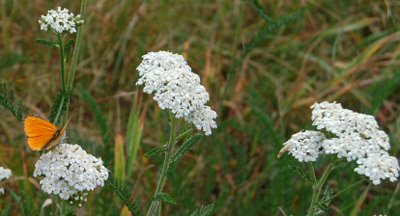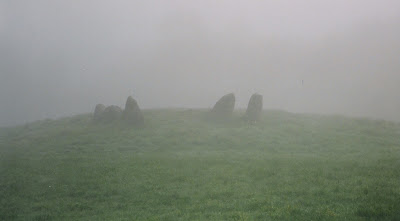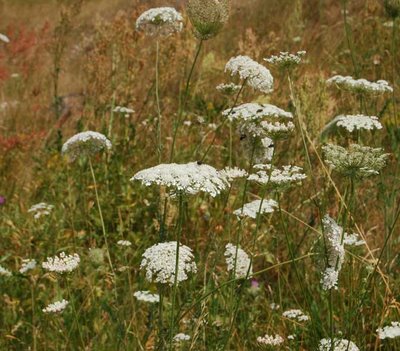 Elverdammen/ The Elf Pond in Bjerre skov, Vejle
Elverdammen/ The Elf Pond in Bjerre skov, Vejle
Last Saturday I was in Bjerre skov near Vejle fjord, and once again I went down to the dark pond with the lotus flowers, which lies deep down in the terrain. I have been here several times, and this place always seems a little sinister to me. Maybe the name Elverdam has got a magic influence. In the old days, before Christianity arrived, people probably considered this pond a sacred place, where they sacrificed to the gods, the elfs, the water nymphs and the nix, who played his violin below water, trying to lure young girls down to him. The Danish name of the nix is
nøkken and the Lotus-flower's Danish name is
Nøkkerose, an obvious and ancient connection to the elf people.
Northern Europe
Elverfolk/Elf-people is a group of supernatural beings from the North European folklore. From the Danish and Swedish folklore they are i.e. fairies, elf girls, elf boys and nixes. In Germany the term is
elfen, in England
elf, in Sweden
älv, in Norway the word
alv is rarely used, it is synonym to
vætter. In tales about the elf people are similarities to other mythological beings from folklore like pixies, the underground people and
huldrer (wood/water nymphs). They were once local gods, but changed with the coming of Christianity into nature spirits, driving out the ancient Nordic mythology. In the 16th century they were considered to be damaging little creatures, while they earlier were seen as creatures of normal human size. Their homes were underground in hills, mountains, springs and water streams.
 Lotus (Nøkkerose) in the Elf Pond
Lotus (Nøkkerose) in the Elf Pond
In early modern time and at present the elfs were in British and Nordic folklore associated to the South European fairies , beautiful little winged creatures. In the Romantic literature of the 19th century the elfs were re-created into their original form, often pictured as young men and women of great beauty, which was the base of the elfs in the 20th century's fantasy literature, especially with R.R.Tolkien. His elfs built highly on the Nordic mythology. In Nordic folklore, which is a mix of Nordic mythology and elements from Christian mythology, are several types of beings, mostly females, who are described as elf people. In Denmark they are named elver or ellefolk, Swedish alv or älva and Norwegian alv. Some underground people er more related to the dwarfs than the elfs. In Denmark and Sweden the nisse and the tomte (both pixies)have many similarities to the underground people, they are primarily connected to the farm and the home.
I Denmark and Sweden the elfs are often described as very beautiful girls with a hole in their back, they lived in the wood, in thicket, in the hills or in the moors together with the elf king - and they are pictured as blonde and dressed in white. they turn into a rage and get evil when insulted - sometimes they try to lure people into death, like lygtemænd. (will-o'-the-wisp). But the elsf were not just young and beautiful. A Swedish fairy tale tells about an elf woman, who in the end saves the heroin on the condition that the king's cattle never graze on her hill again. This elf woman is described as a beautiful elderly woman.
The Elf Pond
The
Elvere (Elf people) danced at gravehills at night and in the fog in the morning. They left a shape of rings where they had danced, the so-called elf ring or witch ring , in reality a ring of fungus. H.C. Andersen tells in
Elverhøj about the elf people's and other nature spirits' feast at Elverhøj on a summer's night. If a human saw the elf dance, he would discover that although it had lasted only a few hours, many years might have passed by in the real world. This is also told by Tolkien in The Lord of the Ring. In some tales the elfs are sickness -spirits, usually in connection to exemia, which in Norway is still named "
elveblest". To protect oneself against evil elf people were used elf cross, carved into buildings and other objects, or a pentagram, which was still in use in the 19th century in Sweden: It was carved or painted on doors, walls and tools to protect against the elfs. A cross was put in a necklace or carved in silver wares, in some areas were crosses placed upon the altar on three consecutive Sundays.
Skålsten (stones with hollows) is a special form of petroglyphs - such stones were found everywhere in Scandinavia and named
elfkvärnar in Sweden, indicating they might have been used in ritual connections where food was sacrificed (like butter) in the hollows to the elfs. It is not cetain how old this custom is and how long it was used. The circular hollows in stones were also interpreted as a female sexual symbol.
Skålsten ( stone with hollows) in church dike,Daugbjerg church, Jutland
In the British folklore the elfs are usually portrayed as little , fickle people, who were often described as invisible, and with an evil personality. They were not exactly evil - they just irritated people. In British tradition the elfs are alike fairies, originating from French and Gaelic folklore. Elfs appear in both English and Scottish ballads and folk tales. These stories often hold a travel to Elphame or Elfland (= Alfheim in Nordic kosmology), a fairy land, which is also a scary and hostile place. The elfs are sometimes described in a positive way, but in other cases they are sinister figures, often murderers or rapists. In most ballads the elf is a male and the queen of Elfland is almost the only mentioned female elf.
In Iceland the belief in huldufolk is still alive, or people will not deny their existence. Maybe this might be a way to promote tourism, but a study from 2007 at Iceland's University showed that more than half of the Icelanders would not reject the existence of elfs or ghosts. A former study from 1974 concluded that the Icelanders are more open to phenomenons like divination, ghosts and elfs than other nations. The Icelandic huldufolk live in mountains and stones.
 Huldremose (the moor of the water nymph) East Jutland
Huldremose (the moor of the water nymph) East Jutland
Their role as damaging creatures has survived. Elf-shot, elf-bolt or elf-arrow origin from Scotland and the northern part of England. The oldest known is in a manuscript from the 16th century, they have also been used for arrowheads of flint from Stone Age. They were given a ritual and healing importance and were said to be used by witches to harm people and their livestock. An "owl" in the hair was called an elf-lock, and a sudden paralysis was sometimes called an elf-stroke.
The elfs are connected to various literature like the medieval epos Nibelungenlied, in William Shakespeare's "A Midsummernight's Dream", Goethe's Erlkönig, probably originating from Denmark, it was actually a Danish story which was translated into German, Erlkönig was put into music by Franz Schubert; in Irish mythology and the house -elfs in J.K.Rowling's Harry Potter books.
 photo Bjerre skov, Vejle , 17. July 2010: grethe bachmann
photo Bjerre skov, Vejle , 17. July 2010: grethe bachmann







































